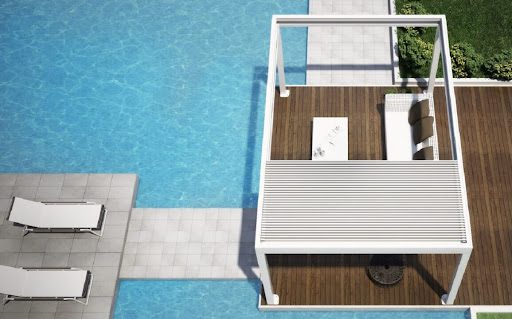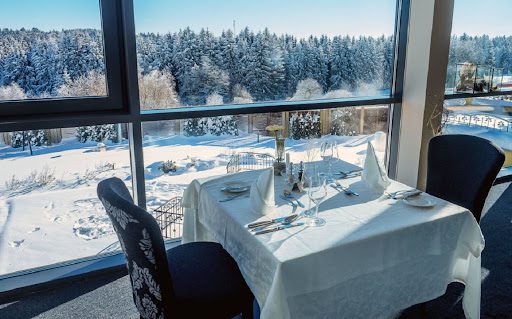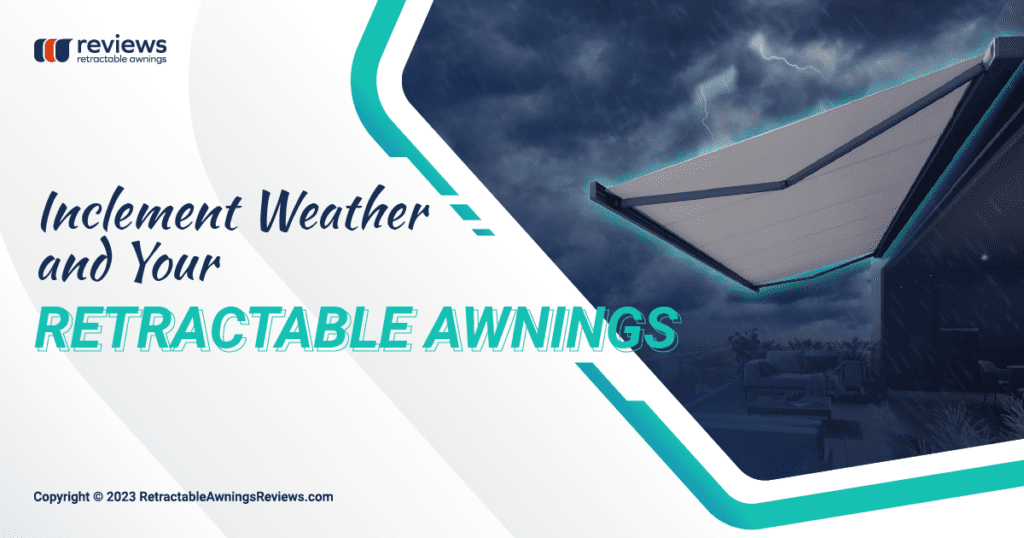Retractable awning products are state-of-the-art shading solution that only improves with time in terms of functionality and features. They’re suitable for numerous applications, including residential, commercial, industrial and institutional buildings, and you can use them even for your camper or recreational vehicle.
If you’ve reached this blog post, you already know a little about retractable awnings and how they can improve your outdoor living space. You may have noticed that quality models cost quite a bit, and you’re wondering if they’re worth it.
Today, I’ll answer all your questions about retractable awnings, their durability and their ability to withstand inclement weather and various outdoor elements. Hopefully, you’ll also learn how to protect them and take care of them to ensure making an investment that will last you for years to come.

Can retractable awnings withstand inclement weather?
Before discussing whether retractable awnings can withstand inclement weather, it’s imperative to define this term.
How do we define inclement weather?
While retractable shading products may handle unfavorable weather conditions, inclement weather is way more severe and unsafe or dangerous for people, animals, outdoor areas and buildings. Governments often have specific protocols to warn citizens about such hazardous situations.
Let’s look at some examples of inclement weather:
- Hurricanes and tropical storms
- Winter and snow storms
- Excessive heat
- High wind speeds
- Flash floods
- Severe thunderstorms
Considerations
Technically speaking, an outdoor structure such as a retractable awning may withstand some of these conditions if made from suitable materials. In addition, it would need to be correctly installed and anchored to the surface.
However, most awnings cannot handle such violent conditions and even less so if they stay extended when they occur. But again, the awning type plays a crucial role. For example, a portable awning would be easily blown away by strong gusts. However, a well-anchored pergola would not give up easily.
Production materials
As mentioned above, production materials are crucial to the durability and resilience of an awning. Production technology has tremendously advanced throughout the years. If 50 years ago, people used fragile organic materials for canvas, today, they use heavy-duty fabrics and reinforcements for superior strength.
But fabrics are not all that matter. Manufacturers strive to produce lightweight yet sturdy frames that can withstand severe outdoor conditions without getting damaged. They use the best materials and additional enhancements to increase durability and longevity.
Certifications
Companies can acquire various certifications if they subject the product to the corresponding testing methods. Such certifications guarantee that your awning will hold on against specific elements and circumstances.
TÜV certification
One of the most widely recognized certifications is the German TÜV. The European Technology Surveillance Association oversees the entire manufacturing process and tests the product to guarantee it meets and exceeds the industry safety and quality standards.
CE marking
Conformité Européenne (CE) marking proves a product meets all European standards and regulations. It is suggestive of the product’s quality and durability.
Beaufort Wind Force Scale Rating
Suppose you live in a windy area with lots of sudden breezes and wind gusts. You want to look at retractable awnings that have been tested according to the Beaufort Wind Force Scale Rating. These are the most reliable tests that indicate at what wind speeds the canopy can continue to perform well (while extended).
Other
Another thing to consider is that additional enhancements such as fire-retardant coating, for example, can be highly beneficial to prevent the fast spreading of fire in case of an accident.
Categorization
Generally, we can divide undesirable weather conditions into the following categories:
- Heavy rain
- Excessive heat and sun rays
- Strong wind
- Snowfall or hail
Let’s discuss each one of these in more detail.
How do they perform against heavy rain?
One of the more commonly asked questions is, “How much rain can my retractable awning handle?”. The answer to this question is: It depends on the awning type and the fabric material.
Lateral (folding) arm and drop-arm awnings
First, if you purchase a lateral arm or drop-arm retractable awning, be prepared and don’t expect it to handle both the intense sun and heavy rain. These structures do not rely on additional support posts and are entirely dependent on the surface you install them on.
All of the above means they have limited weight-bearing capabilities. Adding weight exceeding the structure’s threshold can cause irreversible damage to the awning or the supporting surface. This, on its own, can lead to health and safety hazards.
That’s why solution-dyed acrylic fabrics are the preferred choice for folding arm awnings. The material is lightweight, breathable, and doesn’t add too much extra weight to the awning.
Solution-dyed acrylic is a water-resistant material that, if well-taut and under the right pitch, can cause light rain to run off without pooling at the top and creating water pockets. Additional treatments, such as water-repellent coating, can improve the fabric’s qualities.
Retractable pergola canopies
These are state-of-the-art shading systems that are more than capable of withstanding heavy downpours with fully extended canopies or rotated (closed) louvers.
Reputable companies offer pergola canopies made with heavy-duty waterproof PVC fabrics from world-class manufacturers that will not let a single raindrop fall onto your outdoor area or furniture. Since PVC is notorious for its lower heat and sun resistance, they add top coatings to strengthen its functionality further.
On the other hand, rotating louvered roofs should be made from waterproof and robust materials such as 6063-T6 aluminum. When turned in a fully closed position, these louvers do not leave any space between them, so the water doesn’t penetrate and fall onto the patio area.
High-quality pergolas have integrated gutter systems that help the water drain away from your deck or patio.

How do they perform against harsh sun rays and heat?
The next question you might ask yourself is if retractable awnings perform well under the scorching sun and excessive summer heat. But let’s remember that this is their primary purpose, and they have excellent resistance to such conditions.
If you think about it, the cover is the main component that fights against sun and heat as it is the barrier between UV rays and the covered outdoor area. So the material it is made of is vital to its resistance qualities, whether it’s fabric or metal.
That being said, let’s discuss the possible detrimental effects of hot sun on most awnings and your experience. The following refers to low-quality awnings made of production materials inappropriate for the particular situation and circumstances.
Quick fading
In case you’re interested in folding arm awnings, you’ll notice that manufacturers mostly use acrylic, canvas, vinyl and polyester for the fabric cover.
Each of these materials has different qualities and performance characteristics regarding sun, UV rays and heat protection. Naturally, one is less sensitive to the detrimental effects of the sun, while the others will inevitably fade more quickly.
As you may already know, retractable canopies and covers are stylish and add curb appeal to your property. However, if the fabric fades away, the vibrant colors will no longer catch the eyes of visitors or passersby and instead will suggest negligence and lack of care on the owner’s side.
Wear and tear
Your awning will always be outdoors and exposed to the elements. When it’s not inside its cassette, it will absorb harsh sun rays all day long, casting shade and protecting people, pets and furniture.
However, if the fabric doesn’t have outstanding sun resistance qualities, it will be susceptible to quick natural wear and tear. The sun causes chemical bonds to break down; eventually, the fabric thins out and becomes more prone to breakage.
While additional enhancements and coatings help improve this quality, failing to invest in the right product and material will result in premature fabric deterioration.
Low heat reduction qualities
Some fabrics are incredibly breathable and perfect for heat reduction as they do not trap the heat underneath but let the air flow freely. They create the perfect outdoor atmosphere and can potentially reduce air temperature by up to 20℃.
However, although other fabrics can also create shade, they cannot achieve the same heat reduction and won’t make your outdoor experience as pleasant. You can still enjoy the shade outside, but you won’t feel a significant temperature difference and a nice light breeze.
Ineffective skin protection
As you know, intense UV rays can harm your skin and affect it in various ways like burning, rapid aging and abnormal growth of skin cells. One of the most significant advantages of retractable patio awnings is protecting your skin from these harmful and detrimental effects.
However, if the cover materials are not UV ray resistant, they will fail to complete this task and defeat the point of the awning. There are specific fabric types that even The Skin Cancer Foundation recommends and states are a practical part of a complete skin protection regimen.
Need for replacement
All of the above can cause you to purchase a fabric replacement for your awning too soon after you’ve installed your patio cover. This will turn out to be an additional cost and a time-consuming process. Pay extra attention when choosing your awning cover materials.

How do they perform against strong winds?
When talking about thunderstorms, hurricanes and tornadoes, we must address that high wind speed is detrimental to retractable products and all outdoor structures. To prevent damage, you need sturdy materials and a strong base which won’t be affected by the wind.
Can folding arm retractable awnings withstand wind?
Folding arm awnings are susceptible to wind damage since they rely on wall, soffit or roof mounting brackets and a few screws and bolts. No matter how well attached they are and how professional the installation is, the damage is always within the realm of possibilities if you extend the awning during strong winds.
If you want to choose the best wind-resistant retractable awning model for your deck, balcony or backyard, look at its Beaufort scale rating when selecting it. The scale will give you an idea of how much wind will the extended cover handle before you need to retract it.
Bioclimatic retractable pergolas for heavy winds
Occasional windy days are expected for every location, no matter which part of the world you live in. However, specific areas are geographically predisposed to a concentration of high winds. Bioclimatic pergolas will be your best choice if you live in one of these areas and want an outdoor shading construction.

How do they perform against heavy snowfall and hail?
There are specific types of retractable outdoor products made exclusively for winter conditions.
For example, an acrylic folding arm cover won’t do very well in winter as it won’t hold the additional weight of heavy wet snow. Hail can also damage it since it’s heavy, falls quickly, and can tear the cover.
On the other hand, aluminum pergolas with rotating or retractable roofs will indeed shelter the area outside your house or business without getting damaged. These structures are strong enough to withstand significant amounts of snowfall and hail.

Which are the most durable awning fabrics?
The durability of a material is subjective, as the possible opposing powers are countless. As seen above, certain fabrics are more durable against intense sun, while others are more durable against heavy rain. Also, additional coatings can significantly enhance the durability of your awning cover.
However, depending on the particular awning type, I can recommend selecting a specific fabric type. For example, solution-dyed acrylics from brands such as Sunbrella and Dickson are best suited for folding arm models. Heavy-duty PVC from Ferrari or Mehler would be perfect for a retractable pergola canopy.
Although your vendor can give you a warranty of 10+ years, it doesn’t mean the fabrics will last that long if you don’t take proper care of them.
How to take care of your retractable awning?
Don’t get discouraged if your awning of choice won’t perform well in all weather conditions. What’s best about these structures is that you can keep them safe and preserve them for longer.
All you need to do is learn when to retract your awning. You can safely return the fabric and frame into their cassette, where you’ll shelter them from the inclement weather. If you own or plan to buy a motorized model, you can automate it by installing weather sensors, such as rain sensors.
Such a sensor will detect moisture and precipitation levels and automatically retract the awning to prevent damage. You can also use this technology to keep your shading structure safe from high winds.
What’s worth noting is that if you learn how to clean and maintain your awning properly, you can also significantly increase its lifespan and enjoy its benefits for extended periods.
